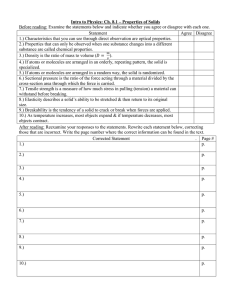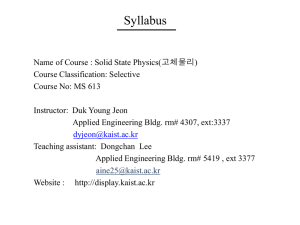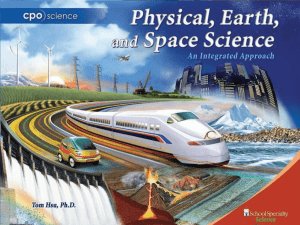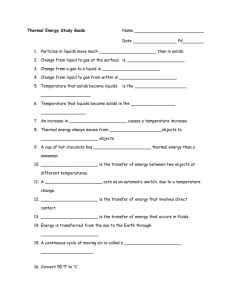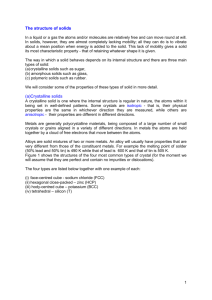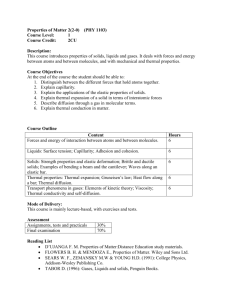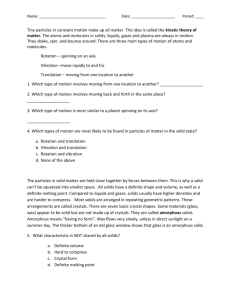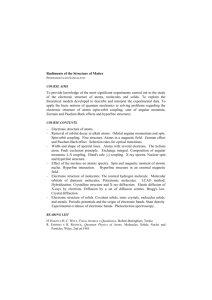8.1 Class Notes
advertisement
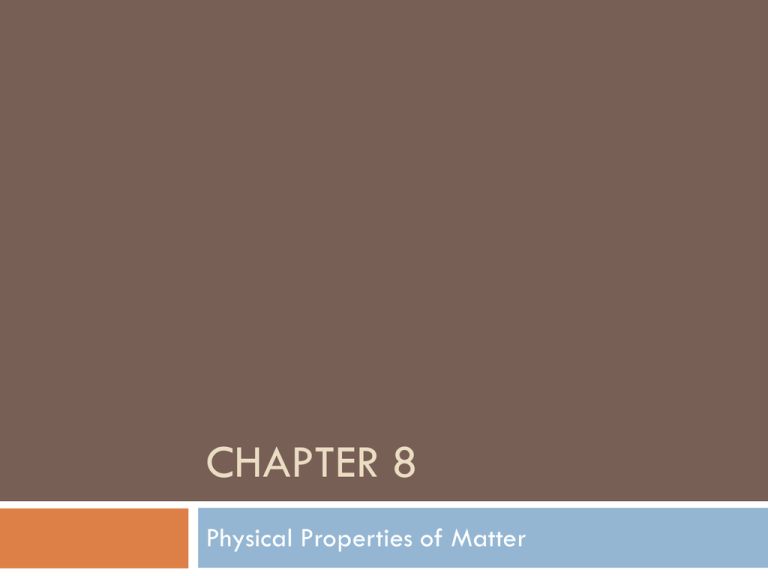
CHAPTER 8 Physical Properties of Matter Vocabulary Physical Properties Chemical Properties Density Crystalline Amorphous Stress Tensile Strength Elasticity Brittleness Thermal Expansion Objectives Distinguish between physical and chemical properties Calculate the density of a substance. Calculate stress. Give examples of brittleness, elasticity, tensile strength, and thermal expansion. 8.1: Properties of Solids Matter has physical and chemical properties. Different types of matter have different characteristics. Characteristics that you can see through direct observation are physical properties. Physical properties include: Color Texture Density Brittleness State – A physical change is any change in the size, shape, or phase of matter in which the identity of a substance does not change. • • – – Physical changes are reversible Ex. When water is frozen it changes from a liquid to a solid – this does not change water into a new substance. Properties that cannot be observed when one substance changes into a different substance are called chemical properties. Any change that transforms one substance into a different substance is called a chemical change. Density is a physical property of matter Density is the ratio of mass to volume. Density is a property of solids liquids and gases. For a material that is the same throughout, the density is the same and does not depend on the amount of material you have. Solids have a wide range of densities. The density of water is 1,000 kg/m3, and many common liquids have densities between 500 and 1,500 kg/m3 The density of air and other gases is much lower. Gases have low density because the molecules in gas are far from each other. Why density varies Atoms have different masses. How closely atoms or molecules are packed together varies. The arrangement of atoms and molecules in solids The atoms or molecules in a solid are arranged in two ways: If the particles are arranged in an orderly, repeating pattern, the solid is called crystalline. If the particles are arranged in a random way, the solid is called amorphous. Crystalline solids Most solids on Earth are crystalline. The shape of a crystal comes from the cubic arrangement of sodium and chlorine atoms. Metal is also a crystalline that is made from tiny crystals fused together in a jumble of different orientations. Amorphous solids Amorphous comes from the Greek for “without shape” Unlike crystals they do not have repetitive patterns in the arrangement of molecules or atoms. Often softer and more elastic Ex. Plastic and glass Solids vary in their strength When you apply a force to an object, the object may change its size, shape or both. The concept of physical “strength” means the ability of a solid object to maintain its shape when force is applied. Strength depends on two questions: How much does the object bend or deform when force is applied? How much force can the object take before it breaks? The strength of an object can be broken down into design and materials. Design means size and shape. The strength of solid materials is described best in terms of stress, not force. Stress is the ratio of the force acting through the material divided by the cross – section area through which the force is carried. The metric unit for stress is the pascal (Pa) One pascal is equal to one newton of force per square meter of area. Tensile strength is a measure of how much stress in pulling, or tension, a material can withstand before breaking. Elasticity, brittleness and bending Elasticity describes a solids ability to be stretched and then return to its original strength. Materials that do not return to their original shape are inelastic. Brittleness is defined as the ability of a solid to crack or break when forces are applied. Bending results when an object stretches in tension on one side and squeezes together in compression on the other side. Thermal expansion As the temperature increases, the kinetic energy in vibration of the atoms and molecules also increases. The increased vibration makes each particles take up a little more space, resulting in thermal expansion. The coefficient of thermal expansion describes how much a material expands for each degree change in temperature. The thermal expansion coefficient works in both ways. If the temperature decreases, objects contract. Very large stresses can develop if objects are prevented from expanding or contraction with temperature. 8.1 Section Review 1. Name one example of a physical change and one example of a chemical change. 2. Aluminum has a density of 2,700 kg/m3. What is the mass if a cube of aluminum that measures 2.5 cm (.025m) on each side? A man weighing 800 N is hanging from a 2mm diameter titanium wire with a cross – section of 3 x 10-6 m2. Will the wire break? Name one example of material for each set of properties: High elasticity and high tensile strength. Amorphous and brittle. Crystalline and brittle. Crystalline and elastic.
